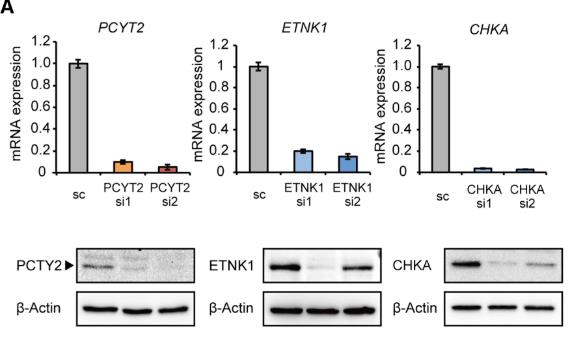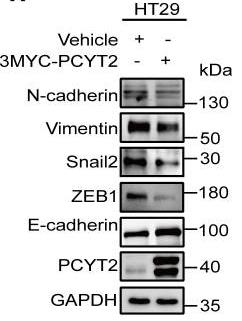PCYT2
-
Official Full Name
phosphate cytidylyltransferase 2, ethanolamine -
Overview
This gene encodes an enzyme that catalyzes the formation of CDP-ethanolamine from CTP and phosphoethanolamine in the Kennedy pathway of phospholipid synthesis. Alternative splicing results in multiple transcript variants. [provided by RefSeq, May 2010] -
Synonyms
PCYT2;phosphate cytidylyltransferase 2, ethanolamine;ET;ethanolamine-phosphate cytidylyltransferase;phosphorylethanolamine transferase;CTP:phosphoethanolamine cytidylyltransferase
Recombinant Proteins
- Human
- Zebrafish
- Rat
- Chicken
- Mouse
- E.coli
- HEK293
- Mammalian Cell
- HEK293T
- Mamanlian cells
- His
- Myc&DDK
- Non
- His&Fc&Avi
- Flag
Background
What is PCYT2 Protein?
The PCYT2 protein, known as phosphoethanolamine cytidylyltransferase 2, is a vital enzyme involved in making phosphatidylethanolamine (PE) through the Kennedy pathway. It's found in various tissues but is particularly abundant in the testes and duodenum. This protein is crucial for cell membrane function by supporting membrane anchoring and participating in processes like cell division, fusion, blood clotting, and programmed cell death. Issues with PCYT2 are linked to hereditary spastic paraplegia and affect muscle health, leading to poor muscle development, weakness, and faster aging. Studies show that PCYT2 activity drops in aging muscles, but gene therapy can help rebuild muscle strength.What is the Function of PCYT2 Protein?
PCYT2, a protein also known as phosphoethanolamine cytidylyltransferase 2, is crucial for creating phosphatidylethanolamine (PE) via the Kennedy pathway. This enzyme partners CTP with phosphoethanolamine to form CDP-ethanolamine. PE makes up a big part of the cell membrane's inner layer and is active in key cellular activities like membrane fusion, the cell cycle, autophagy, and programmed cell death. PCYT2 is vital for keeping lipids in balance and supporting cell growth and development. It's also tied to the regulation of lipid and energy metabolism. In terms of muscle health, PCYT2 is essential; without it, muscles might develop poorly, become weaker over time, and age faster.PCYT2 Related Signaling Pathway
PCYT2 is a protein that plays a key role in several signaling pathways, especially in making phosphatidylethanolamine (PE) and in overall cell metabolism. It helps create CDP-ethanolamine from CTP and phosphoethanolamine, which is a crucial step in producing PE. This component is essential for the structure and function of cell membranes. Besides all that, PCYT2 also gets involved in autophagy, the cell's way of cleaning up. It plays a part in forming autophagosomes and making sure cells survive by tweaking how PE is made. When it comes to cancer, PCYT2 is known to step in and hold back the epithelial-mesenchymal transition (EMT). It does this by affecting how YAP1 is phosphorylated and broken down, which in turn helps stop cancer cells from spreading. These roles highlight the important biological significance of PCYT2 in cell metabolism, autophagy, and cancer development.
Fig1. Glutamine shortage promotes cancer growth by causing phosphoethanolamine accumulation, highlighting glutamine-related pathways as potential treatment targets. (Tsuyoshi Osawa, 2019)
PCYT2 Related Diseases
PCYT2 is one of those proteins that flies under the radar until it starts acting up. It's tied to a bunch of health problems, especially in how our body deals with fats and nerve issues. You might not think about it much, but when things go wrong with PCYT2, it definitely makes its presence known. When PCYT2 isn't doing its job right, it can set the stage for conditions like non-alcoholic steatohepatitis (NASH) and insulin resistance to develop. Not only that, mutations in the PCYT2 gene have been tied to a tricky hereditary condition called spastic paraplegia. This condition doesn't mess around—it can cause global developmental delay, spastic paralysis, seizures, and progressive shrinking of the brain and cerebellum. All this research highlights just how crucial PCYT2 is in keeping lipid balance and the nervous system in check, and when it doesn't function properly, it could lead to the onset and progression of a range of diseases.Bioapplications of PCYT2
PCYT2 is pretty versatile and finds itself being used in research, industry, and even some clinical studies. In the world of research, it's a big deal as a key enzyme involved in making phosphatidylethanolamine, which is important for cell membrane functions, muscle health, and aging. Interestingly, as we age, PCYT2 activity tends to drop, but scientists have found that gene therapy can actually pump up the muscle strength in older mice. Pretty cool, right? On the laboratory front, PCYT2 antibodies are widely used in techniques like Western Blot, immunocytochemistry, immunohistochemistry, and ELISA. These methods are essential for checking out how PCYT2 is expressed in different biological samples. Clinically, mutations in the PCYT2 gene play a role in diseases like hereditary spastic paraplegia. By studying what PCYT2 does, researchers hope to unlock a better understanding of these complex conditions.Case Study
Case Study 1: Osawa T. et al. Cell Rep. 2019
Aggressive cancer cells adapt to harsh conditions like low oxygen and nutrients. It's found that when glutamine is scarce, cancer cells accumulate phosphoethanolamine (PEtn) because of reduced PCYT2, an enzyme needed for its breakdown. This buildup is linked to faster tumor growth during nutrient shortage. Decreased PCYT2 is partly due to less ELF3, a transcription factor. Raising PCYT2 reduces PEtn and slows tumor growth. In breast tumors, more PEtn and less PCYT2 often mean poorer outcomes. This shows that lack of glutamine spurs cancer by affecting phosphatidylethanolamine production, suggesting targeting glutamine-responsive genes could help treat cancer.-
 Fig1. siRNA-mediated reduced expression of PCYT2, ETNK1, and CHKA in HeLa cells.
Fig1. siRNA-mediated reduced expression of PCYT2, ETNK1, and CHKA in HeLa cells. -
 Fig2. Glutamine upregulates PCYT2 mRNA expression in a dose-dependent manner.
Fig2. Glutamine upregulates PCYT2 mRNA expression in a dose-dependent manner.
Case Study 2: Zhou L. et al. JCI Insight. 2024
Researchers found that metabolic changes are key in tumor growth and spread. Lipids, like proteins, send signals by interacting with proteins. The Hippo pathway, when disrupted, contributes to cancer spread by moving YAP1 into the nucleus and activating genes. While PCYT2, an enzyme involved in phosphatidylethanolamine synthesis, has been linked to chemoresistance, its role in metastasis was unclear. They discovered PCYT2 was lower in metastatic colorectal cancer and worked as a metastasis blocker. It boosted the interaction between PEBP1 and the YAP1-phosphatase PPP2R1A, interfering with their connection and increasing phosphorylated YAP1, leading to its degradation. Less YAP1 in the nucleus suppressed genes like ZEB1 and SNAIL2, reducing metastasis.-
 Fig3. Detection of PCYT2 expression in 16 paired CRC tissues (T) and the corresponding adjacent normal tissues (N) by Western blot.
Fig3. Detection of PCYT2 expression in 16 paired CRC tissues (T) and the corresponding adjacent normal tissues (N) by Western blot. -
 Fig4. Detection of epithelial and mesenchymal markers in PCYT2-overexpression HT29 cells.
Fig4. Detection of epithelial and mesenchymal markers in PCYT2-overexpression HT29 cells.
Quality Guarantee
High Purity
-
.jpg) Fig1. SDS-PAGE (PCYT2-2687H)
Fig1. SDS-PAGE (PCYT2-2687H)
Involved Pathway
PCYT2 involved in several pathways and played different roles in them. We selected most pathways PCYT2 participated on our site, such as Glycerophospholipid metabolism,Metabolic pathways, which may be useful for your reference. Also, other proteins which involved in the same pathway with PCYT2 were listed below. Creative BioMart supplied nearly all the proteins listed, you can search them on our site.
| Pathway Name | Pathway Related Protein |
|---|---|
| Metabolic pathways | BCO1L,ALDH3B1,NAPRT,COX7B,XYLT2,UMPS,GNS,RDH10B,QDPRB2,SPR |
| Glycerophospholipid metabolism | LPIN3,PCYT1A,AGXT2L1,LPCAT4,LPGAT1,AGPAT5,PLA2G4C,DGKQ,ADPRM,PHYKPL |
Protein Function
PCYT2 has several biochemical functions, for example, ethanolamine-phosphate cytidylyltransferase activity. Some of the functions are cooperated with other proteins, some of the functions could acted by PCYT2 itself. We selected most functions PCYT2 had, and list some proteins which have the same functions with PCYT2. You can find most of the proteins on our site.
| Function | Related Protein |
|---|
Interacting Protein
PCYT2 has direct interactions with proteins and molecules. Those interactions were detected by several methods such as yeast two hybrid, co-IP, pull-down and so on. We selected proteins and molecules interacted with PCYT2 here. Most of them are supplied by our site. Hope this information will be useful for your research of PCYT2.
GDF9;CRIP2;SETDB1;KDM8;ADAMTS10;DNMT3B;q9wmx2-pro_0000037548
Resources
Related Services
Related Products
References


